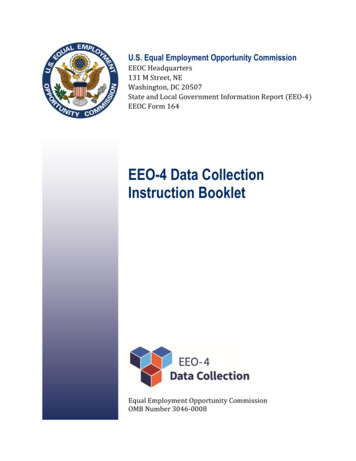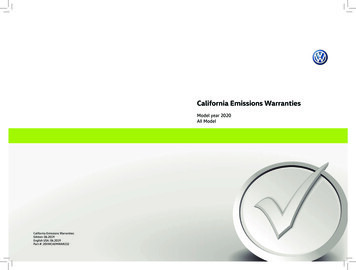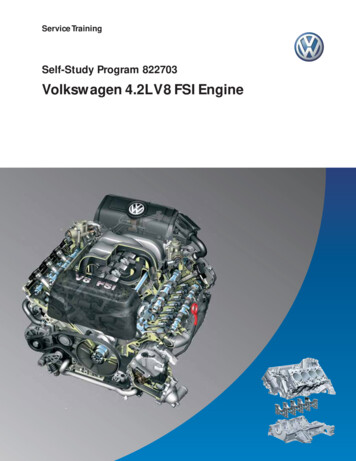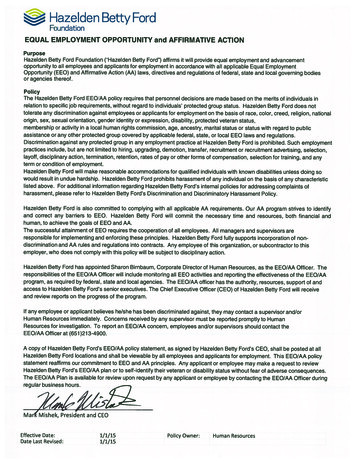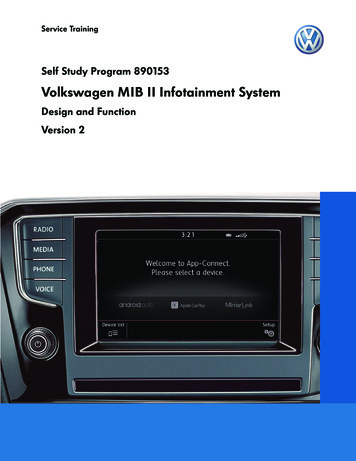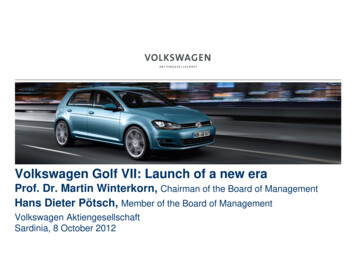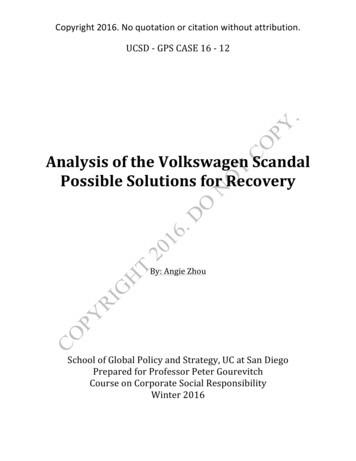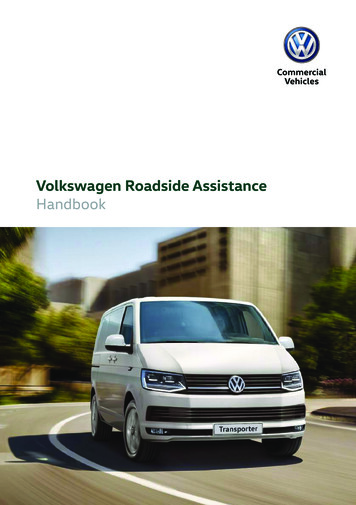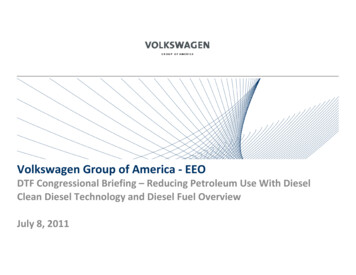
Transcription
Volkswagen Group of America ‐ EEODTF Congressional Briefing – Reducing Petroleum Use With DieselClean Diesel Technology and Diesel Fuel OverviewJuly 88, 2011
Clean Diesel and Diesel Fuel OverviewAgenda Introduction to Clean Diesel Engine TechnologyCurrent Products Four Cylinder Products Six Cylinder ProductsFuture Product PlansLooking Forward – Industry Challenges Criteria Emissions GHG Energy IssuesVW Group Strategy Combustion Engines DieselDil EngineE i ini DetailD il – FutureFPotentialPi l off CleanClDieselDil Biofuels for Diesel Engines Diesel Biofuel Future PotentialSummaryJuly 8, 2011 – DTF Congress BriefingVWGoA - EEO2
Clean Diesel and Diesel Fuel OverviewFirst 25 Years of Diesel Development at the Volkswagen GroupJuly 8, 2011 – DTF Congress BriefingVWGoA – EEO3
Clean Diesel and Diesel Fuel OverviewIntroduction Volkswagen Group clean diesel technology “CleanClean DieselDiesel” means Hydrocarbon (HC) and Carbon Monoxide (CO) oxidation catalyst Nitrogen Oxides (NOx) reduction catalyst Particulate Matter (PM) filter Complies in 50 states – meets California and Federal emissionregulations ULEV II California compliant Federal Tier 2, Bin 5 compliant Engine technology is very sophisticated Four valves per cylinder, double overhead camshafts High and low pressure EGR (Exhaust Gas Recirculation) EGR coolingli Cylinder pressure sensors Common rail fuel injection with 30,000 psi pressurep injectionjevents,, includingg postpinjectionj Multiple Post injection necessary for emission control systemsJuly 8, 2011 – DTF Congress BriefingVWGoA - EEO4
Clean Diesel and Diesel Fuel OverviewVW Group Products – Four Cylinder Volkswagen Jetta Launched summer of 2008 – first VW Group clean diesel Over 100,000 diesel Jettas sold through 2010 Engine specifications: 2.02 0 L four cylinder 140 HP @ 4000 rpm 236 Ft-Lb of torque at 1750 rpm EPA fuel economy label values of 30 city/42 highway This same engine is now offered in the VW Golf and the Audi A3 Current sales mix Jetta sedan: 25 % Diesel Jetta Sportwagen: 80% diesel VW Golf: 50% Diesel Audi A3: 53% Diesel This engine will also be introduced in the new Passat built inCh ttChattanooga– comingi laterl t thisthi yearJuly 8, 2011 – DTF Congress BriefingVWGoA - EEO5
Clean DieselClDil andd DieselDil FuelF l OverviewOiVW Group Product - GolfJuly 8, 2011 – DTF Congress BriefingVWGoA - EEO6
Clean DieselClDil andd DieselDil FuelF l OverviewOiVW Group Product – Audi A3July 8, 2011 – DFT Congress BriefingVWGoA - EEO7
Clean Diesel and Diesel Fuel OverviewVW Group Product VW Touareg and Audi Q7 LaunchedLh d ini theth springi off 2009 Instantly took a large percentage of sales vs. gasoline vehicles Engine specifications: 3.0 L V-6 225 HP @ 3750 RPM 406 Ft-Lb of torque @ 1750 rpm EPA fuel economy label values of 18 city/25 highway Current sales mix VW Touareg: 50% Audi Q7: 43% Audi originally planned for 18-20% diesel penetration in boththe A3 and Q7 - acceptance better than expected Next generation V-6 engine under development for Q5, A6, A8July 8, 2011 – DTF Congress BriefingVWGoA - EEO8
ClCleanDiDiesell andd DieselDil FuelF l OverviewOiVW Group Product – Audi Q7July 8, 2011 – DTF Congress BriefingVWGoA - EEO9
ClCleanDiDieselandl d DieselDil FuelF l OverviewOiVW Group Product - TouaregJuly 8, 2011 – DTF Congress BriefingVWGoA - EEO10
Clean Diesel and Diesel Fuel OverviewIndustry ChallengesEnergyGreenhouse GasesCO2Exhaust Emissions CO, NOX, HC, PM20002005July 8, 2011 – DTF Congress Briefing2010VWGoA – EEO2015202020252030203511
Clean Diesel and Diesel Fuel OverviewMobility Industry Challenges – Criteria Emissions Agencies (EPA, CARB) expected to significantly lower emission standards California: LEV III SULEV (Tier 2, Bin 2) fleet average Reduces HC, CO NOx, PM levels Zero evaporative emissions Lower full useful life off-cycle standards (SFTP) EPA expected to set a similar regulation Tier 3 Future advanced combustion engines expect to comply Both diesel and gasoline concepts LEV III, Tier 3 could be the last set of traditional emission standards Future regulatory focusfhas shiftedfaway ffrom criteria pollutants towards energyissues (policy, security, climate change)July 8, 2011 – DTF Congress BriefingVWGoA – EEO12
ClCleanDiDiesell andd DieselDil FuelF l OverviewOiMobility Industry Challenges – Potential GHG CO2 Targets320280CO 2 [g/mile]240- 3% per year200160- 6% per year12080GHG 1GHG 240002010New CNCars withih0 g/mile CO2201520202025203020352040MYJuly 8, 2011 – DTF Congress BriefingVWGoA – EEO13
Clean Diesel and Diesel Fuel OverviewIndustry Challenges – Example of VW Group generative)RenewableFuel CellCCS SunFuel SynFuelNatural GasOilDiesel FuelGasolineJuly 8, 2011 – DTF Congress BriefingVWGoA – EEOHybridTDI /TSI DSG 14
Clean Diesel and Diesel Fuel OverviewFocus on Efficiency/GHG – Engine/Fuel Technology Advanced combustion concepts will focus on efficiency Significant CO2 reductions are still possible Diesel and GDI (Gasoline Direct Injection) Downsized displacement Fewer cylinders Optimized charging Reduced friction Improved fuel Injection Variable valve timing Variable valve lift Low carbon fuels will also play an important role Liquid fuels make the most sense for a light-duty vehicle Energy density, range Increased use off ethanol and biodiesel is certain B20 for diesel 2nd Generation Diesel? E10 for gasoline E85 Growth?Gth?July 8, 2011 – DTF Congress BriefingVWGoA – EEO15
Clean Diesel and Diesel Fuel OverviewDiesel Developments in Detail The diesel engine currently has A 30% advantage in fuel economy over gasoline engines A 20% advantage in CO2 reduction over gasoline engines From the VW perspective this advantage will continue From the emissions standpoint diesel aftertreatment continues to develop Improved conversion efficiency – SULEV diesel possible Improved durability Lower cost Reduced CO2 penalty From an efficiency standpoint the diesel is also improving 2200 bar (33,000 psi), multi-hole injectors Up to 7 discrete injection events per combustion cycle (rate shaping) Sophisticated high and low pressure EGR systems In cylinder pressure sensors (reduced(cylinder to cylinder variations)) VVT and VVL added to diesels (currently more popular in gasoline engines) From a fuels standpoint deposit control, tighter quality specifications critical Deposits have a big effect on injector performance, spray pattern TighterTi ht tolerancest lhelpsh l calibration,lib tisuchh as cetane,tddensityitJuly 8, 2011 – DTF Congress BreifingVWGoA – EEO16
Clean Diesel and Diesel Fuel OverviewRenewable Diesel Fuel Perspective – An Excellent Biofuel Platform Three major biodiesel types: FAME, HVO, BTL FAME: First generation (SME, RME) VW Group approves B5 methyl ester biodiesel in clean diesel products Primary issue for higher blend is crankcase oil dilution due to post injection Higher boiling range of FAME results in biodiesel collecting in engineoil – this could result in engine failure The same issue exists in Europe – B10 testing showed concern B7 RME compromise recently reached for diesels with aftertreatment Secondary issues are shelf life, oxidation and fuel quality concerns BTL, HVO do not have these concerns Lower boiling range similar to petroleum diesel characteristics No issues with higher level blends Future steps: FAME: VW Group investigating B20 FAME for the US market Higher level blends may be possible through application changes Potential to lower dilution resulting from post injection Potential to improve other FAME properties QuaQualityty oof FAME biodieselb od ese iss improvingpo g HVO, BTL: No issues accepting these fuels – HVO use increasing in Europe BTL is an excellent fuel: 0 sulfur, 0 aromatics, 70 cetaneJuly 8, 2011 – DTF Congress Briefing.VWGoA - EEO17
Clean Diesel and Diesel Fuel OverviewRenewableAlternative FuelsVolkswagen FocusNatural GasSynFuelHybridTDI /TSI Diesel FuelOilDSG GasolineFOGRGLEFCLBLCMENSBGSLMPWEGFPSFuel CellCCS SunFuel OBSHJuly 8, 2011 – DTF Congress Briefing.2HCCVWGoA – EEO18
ElectrotractionElectricityClCleanDiDiesell andd DieselDil FuelF lSynergies in New Combustion ProcessRenewableHigh Pressure InjectionOilDiesel FuelGasolineHybridTDI /TSI DSG PartiallyAuto‐IgnitionHigh Pressure InjectionChargingChargingDirect InjectionDirect InjectionSwirl ChamberJuly 8, 2011 – DTF Congress Briefing.SynFuelNatural GasFuel CellCCS SunFuel CCS Partially homogenizedHydrogen(Regenerative)Port InjectionVWGoA – EEO19
Clean Diesel and Diesel FuelFuture Combustion Engine Potential Convergence of diesel and gasoline technology provides interesting opportunity “Combined”“C bi d” enginei may maximizei i efficiencyffi iwithith lowlenginei outt emissionsi i VW Group examining both diesel and gasoline as base fuel Also including BTL and cellulosic ethanol as candidate fuels Current conclusion is that a new fuel is needed NapthaN th a possibleibl fuelf l Research work continues on CCS Current focus StoichiometricSt i hit i gasolineli withith ethanolthl blendsbl d Lean burn diesel with biodiesel blends FAME at higher blend levels than B5 Properties and quality are improving HVO alsol a recommendedd d blblendingdifuelf l Favorable characteristics Can be immediately used at higher blend levels BTL is still considered in the longer term ExcellentEll t fuelf l propertiesti No issues with blend levelsJuly 8, 2011 – DTF Congress BriefingVWGoA – EEO20
Clean Diesel and Diesel Fuel StrategyCurrent Volkswagen Powertrain and Fuel StrategyHydrogen(regenerative)Renewablenatural gasElectricdriveElectricitySunFuel CelluloseEthanolFuel cellHybridSynFuelCNGTDI/TSI/DSGpetroleumJuly 8,, 2011 – DTF Congress BriefingDieselGasolineVWGoA – EEO21
Clean Diesel and Diesel Fuel Overview Volkswagen Jetta Clean Diesel and Diesel Fuel Overview VW Group Products - Four Cylinder Launched summer of 2008 - first VW Group clean diesel Over 100,000 diesel Jettas sold through 2010 Engine specifications: 2 0 L four cylinder2.0 L four cylinder 140 HP @ 4000 rpm 236 Ft-Lb of torque at 1750 rpm
